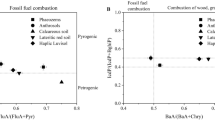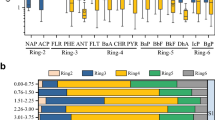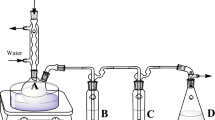Abstract
Polycyclic aromatic hydrocarbons (PAHs) are generated by a range of industrial processes including petroleum and gas production and are often found in high concentrations at industrial sites. Once PAHs enter the environment, the predominant mechanisms for removal are biological via microbial activity. However, PAHs have the potential to partition onto soil organic matter thereby decreasing their bioavailability to microorganisms and limiting their degradation. This explanation was felt to be the reason for a lack of evidence of PAH biodegradation in a study of long-term contaminated soils. To test the hypothesis that bioavailability was a limiting factor for biodegradation in theses soils, PAH bioavailability was determined using nonexhaustive extraction (propanol, butanol, hydrooxypropyl-β-cyclodextrin) and oxidation (persulfate) methodologies designed to determine the fraction of contaminants within soil which are available for biological uptake. The assays gave varying results for each soil, and no specific trends across all soils were observed. PAH bioaccessibility, derived from the HP-β-CD assay which has been the most extensively tested in the literature, was estimated to be between 0 and 10 % for most soils, with the exception of pyrene, indicating that a large fraction of the soil-borne PAHs at the site are not available to microorganisms and that bioavailability limitations may be a primary cause for the lack of observed biodegradation at this site. These results highlight the importance of bioavailability to PAH degradation as well as the relevance of utilizing an assay that has been evaluated across many soil conditions and parameters.


Similar content being viewed by others
References
Abdel-Rahman, M. S., Skowronski, G. A., & Turkall, R. M. (1992). Effects of soil on the bioavailability of m-xylene after oral or dermal exposure. Soil and Sediment Contamination, 1(2), 183–196.
Alexander, M. (2000). Aging, bioavailability, and overestimation of risk from environmental pollutants. Environmental Science and Technology, 34(20), 4259–4265.
Allan, I. J., Semple, K. T., Hare, R., & Reid, B. J. (2006). Prediction of mono-and polycyclic aromatic hydrocarbon degradation in spiked soils using cyclodextrin extraction. Environmental Pollution, 144(2), 562–571.
Amellal, N., Portal, J. M., & Berthelin, J. (2001). Effect of soil structure on the bioavailability of polycyclic aromatic hydrocarbons within aggregates of a contaminated soil. Applied Geochemistry, 16(14), 1611–1619.
Bonten, L. T. C. (2001). Improving bioremediation of PAH contaminated soils by thermal pretreatment. Ph.D. Thesis, Wageningen University, The Netherlands
Bosma, T. N. P., Middeldorp, P. J. M., Schraa, G., & Zehnder, A. J. B. (1996). Mass transfer limitation of biotransformation: quantifying bioavailability. Environmental Science and Technology, 31(1), 248–252.
Bowmer, K. H. (1991). Atrazine persistence and toxicity in two irrigated soils of Australia. Soil Research, 29(2), 339–350.
Breedveld, G. D., & Karlsen, D. A. (2000). Estimating the availability of polycyclic aromatic hydrocarbons for bioremediation of creosote contaminated soils. Applied Microbiology and Biotechnology, 54(2), 255–261.
Cachada, A., Pato, P., Rocha-Santos, T., da Silva, E. F., & Duarte, A. C. (2012). Levels, sources and potential human health risks of organic pollutants in urban soils. Science of the Total Environment, 430, 184–192.
Caldini, G., Cenci, G., Manenti, R., & Morozzi, G. (1995). The ability of an environmental isolate of Pseudomonas fluorescens to utilize chrysene and other four-ring polynuclear aromatic hydrocarbons. Applied Microbiology and Biotechnology, 44(1), 225–229.
Cerniglia, C. E. (1992). Biodegradation of polycyclic aromatic hydrocarbons. Biodegradation, 3(2), 351–368.
Cerniglia, C. E. (1997). Fungal metabolism of polycyclic aromatic hydrocarbons: past, present and future applications in bioremediation. Journal of Industrial Microbiology and Biotechnology, 19(5), 324–333.
Cerniglia, C. E., & Sutherland, J. B. (2010). Degradation of polycyclic aromatic hydrocarbons by fungi. In K. N. Timmis (Ed.), Handbook of hydrocarbon and lipid microbiology (pp. 2079–2110). Berlin: Springer.
Chung, N., & Alexander, M. (2002). Effect of soil properties on bioavailability and extractability of phenanthrene and atrazine sequestered in soil. Chemosphere, 48(1), 109–115.
Cornelissen, G., Rigterink, H., Ferdinandy, M. M. A., & Van Noort, P. C. M. (1998). Rapidly desorbing fractions of PAHs in contaminated sediments as a predictor of the extent of bioremediation. Environmental Science and Technology, 32(7), 966–970.
Cuypers, C., Grotenhuis, T., Joziasse, J., & Rulkens, W. (2000). Rapid persulfate oxidation predicts PAH bioavailability in soils and sediments. Environmental Science and Technology, 34(10), 2057–2063.
Cuypers, C., Pancras, T., Grotenhuis, T., & Rulkens, W. (2002). The estimation of PAH bioavailability in contaminated sediments using hydroxypropyl-β-cyclodextrin and Triton X-100 extraction techniques. Chemosphere, 46(8), 1235–1245.
Doick, K. J., Dew, N. M., & Semple, K. T. (2005). Linking catabolism to cyclodextrin extractability: determination of the microbial availability of PAHs in soil. Environmental Science and Technology, 39(22), 8858–8864.
Doick, K. J., Clasper, P. J., Urmann, K., & Semple, K. T. (2006). Further validation of the HPCD-technique for the evaluation of PAH microbial availability in soil. Environmental Pollution, 144(1), 345–354.
Erickson, D. C., Loehr, R. C., & Neuhauser, E. F. (1993). PAH loss during bioremediation of manufactured gas plant site soils. Water Research, 27(5), 911–919.
Fiala, Z., Vyskocil, A., Krajak, V., Masin, V., Emminger, S., Srb, V., et al. (1999). Polycyclic aromatic hydrocarbons, I. Environmental contamination and environmental exposure. Acta Medica, 42(2), 77–89.
Green, C. T., & Scow, K. M. (2000). Analysis of phospholipid fatty acids (PLFA) to characterize microbial communities in aquifers. Hydrogeology Journal, 8(1), 126–141.
Habe, H., & Omori, T. (2003). Genetics of polycyclic aromatic hydrocarbon metabolism in diverse aerobic bacteria. Bioscience, Biotechnology, and Biochemistry, 67(2), 225–307.
Haritash, A. K., & Kaushik, C. P. (2009). Biodegradation aspects of polycyclic aromatic hydrocarbons (PAHs): a review. Journal of Hazardous Materials, 169(1), 1–15.
Harvey, R. G. (1996). Mechanisms of carcinogenesis of polycyclic aromatic hydrocarbons. Polycyclic Aromatic Compounds, 9(1–4), 1–23.
Heijden, S. A., & Jonker, M. T. O. (2009). PAH bioavailability in field sediments: comparing different methods for predicting in situ bioaccumulation. Environmental Science and Technology, 43(10), 3757–3763.
Hickman, Z. A., Swindell, A. L., Allan, I. J., Rhodes, A. H., Hare, R., Semple, K. T., et al. (2008). Assessing biodegradation potential of PAHs in complex multi-contaminant matrices. Environmental Pollution, 156(3), 1041–1045.
Hinga, K. R. (2003). Degradation rates of low molecular weight PAH correlate with sediment TOC in marine subtidal sediments. Marine Pollution Bulletin, 46(4), 466–474.
Huesemann, M. H., Hausmann, T. S., & Fortman, T. J. (2002). Microbial factors rather than bioavailability limit the rate and extent of PAH biodegradation in aged crude oil contaminated model soils. Bioremediation Journal, 6(4), 321–336.
Huesemann, M. H., Hausmann, T. S., & Fortman, T. J. (2003). Assessment of bioavailability limitations during slurry biodegradation of petroleum hydrocarbons in aged soils. Environmental Toxicology and Chemistry, 22(12), 2853–2860.
Huesemann, M. H., Hausmann, T. S., & Fortman, T. J. (2004). Does bioavailability limit biodegradation? A comparison of hydrocarbon biodegradation and desorption rates in aged soils. Biodegradation, 15(4), 261–274.
Isaacson, P. J., & Frink, C. R. (1984). Nonreversible sorption of phenolic compounds by sediment fractions: the role of sediment organic matter. Environmental Science and Technology, 18(1), 43–48.
Jacques, R. J. S., Santos, E. C., Bento, F. M., Peralba, M. C. R., Selbach, P. A., Sá, E. L. S., et al. (2005). Anthracene biodegradation by Pseudomonas sp. isolated from a petrochemical sludge landfarming site. International Biodeterioration and Biodegradation, 56(3), 143–150.
Jones, K. C., Stratford, J. A., Tidridge, P., Waterhouse, K. S., & Johnston, A. E. (1989). Polynuclear aromatic hydrocarbons in an agricultural soil: long-term changes in profile distribution. Environmental Pollution, 56(4), 337–351.
Juhasz, A. L., & Naidu, R. (2000). Bioremediation of high molecular weight polycyclic aromatic hydrocarbons: a review of the microbial degradation of benzo[a]pyrene. International Biodeterioration and Biodegradation, 45(1–2), 57–88.
Juhasz, A. L., Megharaj, M., & Naidu, R. (2000). Bioavailability: the major challenge (constraint) to bioremediation of organically contaminated soils. In D. Wise, D. J. Trantolo, E. J. Cichon, H. I. Inyang, & U. Stottmeister (Eds.), Remediation engineering of contaminated soils (pp. 217–241). New York: Marcel Dekker, Inc.
Juhasz, A. L., Waller, N., & Stewart, R. (2005). Predicting the efficacy of polycyclic aromatic hydrocarbon bioremediation in creosote-contaminated soil using bioavailability assays. Bioremediation Journal, 9(2), 99–114.
Juhasz, A. L., Smith, E., Waller, N., Stewart, R., & Weber, J. (2010). Bioavailability of residual polycyclic aromatic hydrocarbons following enhanced natural attenuation of creosote-contaminated soil. Environmental Pollution, 158(2), 585–591.
Katayama, A., Bhula, R., Burns, G. R., Carazo, E., Felsot, A., Hamilton, D., et al. (2010). Bioavailability of xenobiotics in the soil environment. In Reviews of environmental contamination and toxicology, vol. 203 (pp. 1–86). New York: Springer.
Kelsey, J. W., & Alexander, M. (1997). Declining bioavailability and inappropriate estimation of risk of persistent compounds. Environmental Toxicology and Chemistry, 16(3), 582–585.
Kelsey, J. W., Kottler, B. D., & Alexander, M. (1996). Selective chemical extractants to predict bioavailability of soil-aged organic chemicals. Environmental Science and Technology, 31(1), 214–217.
Khan, S. U., & Ivarson, K. C. (1982). Release of soil bound (nonextractable) residues by various physiological groups of microorganisms. Journal of Environmental Science and Health. Part. B, 17(6), 737–749.
Kim, S. J., Kweon, O., Jones, R. C., Freeman, J. P., Edmondson, R. D., & Cerniglia, C. E. (2007). Complete and integrated pyrene degradation pathway in Mycobacterium vanbaalenii PYR-1 based on systems biology. Journal of Bacteriology, 189(2), 464–472.
Kiyohara, H., Torigoe, S., Kaida, N., Asaki, T., Iida, T., Hayashi, H., et al. (1994). Cloning and characterization of a chromosomal gene cluster, pah, that encodes the upper pathway for phenanthrene and naphthalene utilization by Pseudomonas putida OUS82. Journal of Bacteriology, 176(8), 2439–2443.
Lee, P. H., Ong, S. K., Golchin, J., & Nelson, G. L. (2001). Use of solvents to enhance PAH biodegradation of coal tar. Water Research, 35(16), 3941–3949.
Liste, H. H., & Alexander, M. (2002). Butanol extraction to predict bioavailability of PAHs in soil. Chemosphere, 46(7), 1011–1017.
Mahmoudi, N., Slater, G. F., & Fulthorpe, R. R. (2011). Comparison of commercial DNA extraction kits for isolation and purification of bacterial and eukaryotic DNA from PAH-contaminated soils. Canadian Journal of Microbiology, 57(8), 623–628.
Mahmoudi, N., Fulthorpe, R. R., Burns, L., Mancini, S., & Slater, G. F. (2012). Assessing microbial carbon sources and potential PAH degradation using natural abundance 14C analysis. Environmental Pollution (in press).
Maier, R. (2000). Bioavailability and its importance to bioremediation. In J. J. Valdes (Ed.), Bioremediation (pp. 59–78). Massachusetts: Kluwer Academic Publishers.
Menn, F. M., Applegate, B. M., & Sayler, G. S. (1993). NAH plasmid-mediated catabolism of anthracene and phenanthrene to naphthoic acids. Applied and Environmental Microbiology, 59(6), 1938–1942.
Morrison, D. E., Robertson, B. K., & Alexander, M. (2000). Bioavailability to earthworms of aged DDT, DDE, DDD, and dieldrin in soil. Environmental Science and Technology, 34(4), 709–713.
Nam, K., & Alexander, M. (1998). Role of nanoporosity and hydrophobicity in sequestration and bioavailability: tests with model solids. Environmental Science and Technology, 32(1), 71–74.
Papadopoulos, A., Paton, G. I., Reid, B. J., & Semple, K. T. (2007a). Prediction of PAH biodegradation in field contaminated soils using a cyclodextrin extraction technique. Journal of Environmental Monitoring, 9(6), 516–522.
Papadopoulos, A., Semple, K. T., & Reid, B. J. (2007b). Prediction of microbial accessibility of carbon-14-phenanthrene in soil in the presence of pyrene or benzo[a]pyrene using an aqueous cyclodextrin extraction technique. Journal of Environmental Quality, 36(5), 1385–1391.
Pavanello, S., & Lotti, M. (2012). Internal exposure to carcinogenic polycyclic aromatic hydrocarbons and DNA damage. Archives of Toxicology, 86(11), 1–3.
Peng, R. H., Xiong, A. S., Xue, Y., Fu, X. Y., Gao, F., Zhao, W., et al. (2008). Microbial biodegradation of polyaromatic hydrocarbons. FEMS Microbiology Reviews, 32(6), 927–955.
Pignatello, J. J., & Xing, B. (1995). Mechanisms of slow sorption of organic chemicals to natural particles. Environmental Science and Technology, 30(1), 1–11.
Pinyakong, O., Habe, H., & Omori, T. (2003). The unique aromatic catabolic genes in sphingomonads degrading polycyclic aromatic hydrocarbons (PAHs). Journal of General and Applied Microbiology, 49(1), 1–19.
Reid, B. J., Stokes, J. D., Jones, K. C., & Semple, K. T. (2000). Nonexhaustive cyclodextrin-based extraction technique for the evaluation of PAH bioavailability. Environmental Science and Technology, 34(15), 3174–3179.
Robertson, B. K., & Alexander, M. (1998). Sequestration of DDT and dieldrin in soil: disappearance of acute toxicity but not the compounds. Environmental Toxicology and Chemistry, 17(6), 1034–1038.
Rostami, I., & Juhasz, A. L. (2011). Assessment of persistent organic pollutant (POP) bioavailability and bioaccessibility for human health exposure assessment: a critical review. Critical Reviews in Environmental Science and Technology, 41(7), 623–656.
Roy, T. A., & Singh, R. (2001). Effect of soil loading and soil sequestration on dermal bioavailability of polynuclear aromatic hydrocarbons. Bulletin of Environmental Contamination and Toxicology, 67(3), 324–331.
Samanta, S. K., Chakraborti, A. K., & Jain, R. K. (1999). Degradation of phenanthrene by different bacteria: evidence for novel transformation sequences involving the formation of 1-naphthol. Applied Microbiology and Biotechnology, 53(1), 98–107.
Scribner, S. L., Boyd, S. A., Benzing, T. R., & Sun, S. (1992). Desorption and unavailability of aged simazine residues in soil from a continuous corn field. Journal of Environmental Quality, 21(1), 115–120.
Semple, K. T., Doick, K. J., Jones, K. C., Burauel, P., Craven, A., & Harms, H. (2004). Defining bioavailability and bioaccessibility of contaminated soil and sediment is complicated. Environmental Science and Technology, 38(12), 228–231.
Semple, K. T., Doick, K. J., Wick, L. Y., & Harms, H. (2007). Microbial interactions with organic contaminants in soils: definitions, processes and measurement. Environmental Pollution, 150(1), 166–176.
Shuttleworth, K. L., & Cerniglia, E. (1995). Environmental aspects of PAH biodegradation. Applied Biochemistry and Biotechnology, 54(1), 291–302.
Singh, A., Van Hamme, J. D., & Ward, O. P. (2007). Surfactants in microbiology and biotechnology: Part 2. Application aspects. Biotechnology Advances, 25(1), 99–121.
Slater, G. F., White, H. K., Eglinton, T. I., & Reddy, C. M. (2005). Determination of microbial carbon sources in petroleum contaminated sediments using molecular 14C analysis. Environmental Science and Technology, 39(8), 2552–2558.
Stokes, J. D., Wilkinson, A., Reid, B. J., Jones, K. C., & Semple, K. T. (2005). Prediction of polycyclic aromatic hydrocarbon biodegradation in contaminated soils using an aqueous hydroxypropyl-beta-cyclodextrin extraction technique. Environmental Toxicology and Chemistry, 24(6), 1325–1330.
Stroud, J. L., Paton, G. I., & Semple, K. T. (2009). Predicting the biodegradation of target hydrocarbons in the presence of mixed contaminants in soil. Chemosphere, 74(4), 563–567.
Tang, J., & Alexander, M. (1999). Mild extractability and bioavailability of polycyclic aromatic hydrocarbons in soil. Environmental Toxicology and Chemistry, 18(12), 2711–2714.
Thibault, S. L., Anderson, M., & Frankenberger, W. T. (1996). Influence of surfactants on pyrene desorption and degradation in soils. Applied and Environmental Microbiology, 62(1), 283.
Tiehm, A. (1994). Degradation of polycyclic aromatic hydrocarbons in the presence of synthetic surfactants. Applied and Environmental Microbiology, 60(1), 258.
Ting, W. T. E., Yuan, S. Y., Wu, S. D., & Chang, B. V. (2011). Biodegradation of phenanthrene and pyrene by Ganoderma lucidum. International Biodeterioration and Biodegradation, 65(1), 238–242.
Van Hamme, J. D., Singh, A., & Ward, O. P. (2003). Recent advances in petroleum microbiology. Microbiology and Molecular Biology Reviews, 67(4), 503–549.
van Herwijnen, R., Wattiau, P., Bastiaens, L., Daal, L., Jonker, L., Springael, D., et al. (2003). Elucidation of the metabolic pathway of fluorene and cometabolic pathways of phenanthrene, fluoranthene, anthracene and dibenzothiophene by Sphingomonas sp. LB126. Research in Microbiology, 154(3), 199–206.
Volkering, F., Breure, A. M., van Andel, J. G., & Rulkens, W. H. (1995). Influence of nonionic surfactants on bioavailability and biodegradation of polycyclic aromatic hydrocarbons. Applied and Environmental Microbiology, 61(5), 1699–1705.
Wang, J., Chen, S., Tian, M., Zheng, X., Gonzales, L., Ohura, T., et al. (2012). Inhalation cancer risk associated with exposure to complex polycyclic aromatic hydrocarbon mixtures in an electronic waste and urban area in South China. Environmental Science and Technology, 46(17), 9745–9752.
Weissenfels, W. D., Klewer, H. J., & Langhoff, J. (1992). Adsorption of polycyclic aromatic hydrocarbons (PAHs) by soil particles: influence on biodegradability and biotoxicity. Applied Microbiology and Biotechnology, 36(5), 689–696.
Xu, H. X., Wu, H. Y., Qiu, Y. P., Shi, X. Q., He, G. H., Zhang, J. F., et al. (2011). Degradation of fluoranthene by a newly isolated strain of Herbaspirillum chlorophenolicum from activated sludge. Biodegradation, 22(2), 335–345.
Yang, J. J., Roy, T. A., Krueger, A. J., Neil, W., & Mackerer, C. R. (1989). In vitro and in vivo percutaneous absorption of benzo[a]pyrene from petroleum crude-fortified soil in the rat. Bulletin of Environmental Contamination and Toxicology, 43(2), 207–214.
Yuan, S. Y., Chang, J. S., Yen, J. H., & Chang, B. V. (2001). Biodegradation of phenanthrene in river sediment. Chemosphere, 43(3), 273–278.
Zhang, W., Bouwer, E. J., & Ball, W. P. (1998). Bioavailability of hydrophobic organic contaminants: effects and implications of sorption-related mass transfer on bioremediation. Ground Water Monitoring & Remediation, 18(1), 126–138.
Zhu, H., & Aitken, M. D. (2010). Surfactant-enhanced desorption and biodegradation of polycyclic aromatic hydrocarbons in contaminated soil. Environmental Science and Technology, 44(19), 7260–7265.
Acknowledgments
The authors thank John Weber (University of South Australia) and Jennie Kirby (McMaster University) for their laboratory assistance and technical expertise. Thank you also to Leanne Burns, Silvia Mancini and Gillian Roos of Golder Associates Ltd. for providing the soil samples used in this study. This work was funded by grants to GFS and a scholarship to NM from the Natural Sciences & Engineering Research Council of Canada.
Author information
Authors and Affiliations
Corresponding author
Rights and permissions
About this article
Cite this article
Mahmoudi, N., Slater, G.F. & Juhasz, A.L. Assessing Limitations for PAH Biodegradation in Long-Term Contaminated Soils Using Bioaccessibility Assays. Water Air Soil Pollut 224, 1411 (2013). https://doi.org/10.1007/s11270-012-1411-2
Received:
Accepted:
Published:
DOI: https://doi.org/10.1007/s11270-012-1411-2




